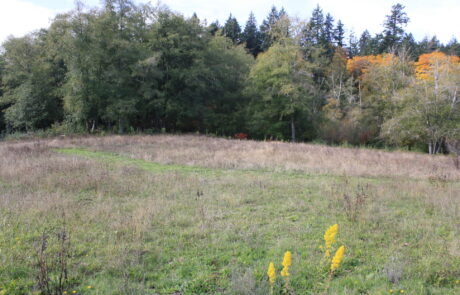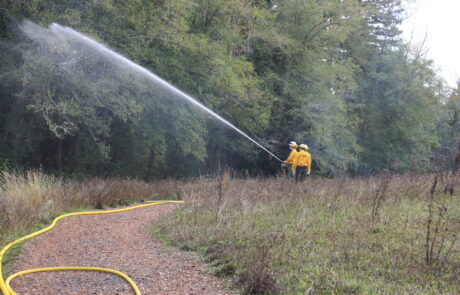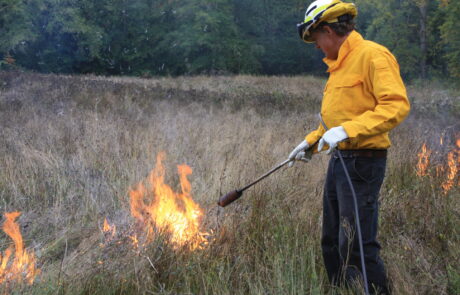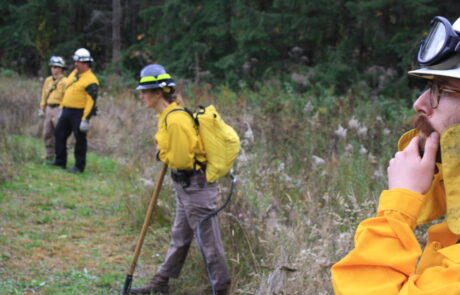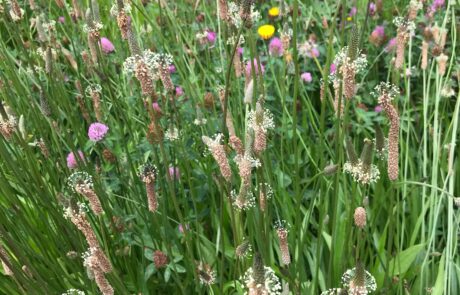Buxton Pollinator Meadow Management
An Evolving Ecosystem
Bloedel Reserve is committed to establishing a high value, diverse, pollinator-friendly plant community in the Buxton Pollinator Meadow. The Meadow is a young, evolving ecosystem that requires us to constantly adapt our management practices to changing conditions. Following a failed prescribed burn attempt in 2020 and a burn ban remaining in effect for most of fall 2021, invasive pasture grasses have reestablished to a degree that attempts to increase wildflower cover have become largely futile.
Grazing Animals for Managing the Buxton Bird Marsh and Pollinator Meadow at Bloedel Reserve
As 2024 progresses in the Buxton Bird Marsh and Pollinator Meadow, our staff continues to experiment with ecologically friendly methods for reducing the cover of non-native pasture grasses in order to establish a greater quantity and diversity of flowering herbs.
Prior to the meadow conversion process, the Pollinator Meadow was sheep pasture, densely populated with a collection of Eurasian perennial grass species. The dense and extensive root systems of these returned pasture grass plants dominate the current meadow composition and act to prevent any further establishment of flowering herbs or native, desirable grasses. For the originally envisioned landscape of colorful, diverse wildflowers intermixed with native bunchgrasses to be realized, clearing the pasture grasses from the meadow is necessary.
Although grazing and browsing animals such as goats, sheep, pigs, and chickens are primarily raised for agricultural purposes, they are also used for land clearing and management. Chickens, like pigs, attack the roots of plants in their efforts to find soil-born insects and seeds. On confined sites, their persistent scratching and foraging activities can eradicate herbaceous vegetation and significantly reduce the quantity of undesirable seeds stored in the soil. In addition to being highly effective, using animals to remove undesirable vegetation is among the most ecologically friendly methods available for the targeted removal of vegetation from a site. Beyond improving meadow conditions, the presence of grazing animals at Bloedel Reserve allows for the development of partnerships with local organic farms and food banks, and presents myriad opportunities for public education, learning, and outreach.
With the careful oversight of experienced Bloedel Reserve Staff members, this pilot project will span 7-8 months; in that time, 20 hens housed in a predator-proof enclosure in the Meadow will be used to clear an 800 sqft rectangular area of invasive pasture grasses.
FAQ’s
Q. How many chickens will there be in the meadow?
A. 20 chickens will be housed in the meadow, weather-dependent, from late April through mid-November to maximize the warmest months of the year.
Q. What breed of chickens will be used?
A. The breed of the chicks will be the ‘Speckled Sussex’, an attractive bird selected for their mild and friendly temperament, voracious foraging and scratching tendencies, and camouflaging colors.
Q. How will they be housed and protected?
A. The chickens will be safely confined within a portable, predator proof enclosure called a chicken tractor. The chicken tractor has a metal mesh roof that will protect the hens from raptors.
Q. Will predators attack the animals?
A. The chance of predators attacking and killing the chickens is slim, though it remains a potential threat. The chicken tractor is outfitted with enhanced predator protections, including the addition of roosting perches to keep the hens off the ground overnight, and the installation of an extra layer of protective chicken wire around the bottom two feet of the enclosure to prevent raccoon grabs.
Q. Can visitors interact with the chickens?
A. There will be several locations and opportunities for visitors to observe and interact with both the baby chicks and the mature hens up close, although handling chicks and chickens will not be permitted.
Q. Do the chickens present any danger to visitors or to the surrounding area?
A. No. The chickens will be in an enclosure that prevents them from escaping into the meadow or gardens but allows them to be visible to the public.
Q. What happens after the chickens are removed from the meadow?
A. Once the chickens have been relocated for the winter, the cleared site will be prepared for seed sowing. Measures will be taken to counter the fertilizing effect of the excess nitrogen from chicken droppings.
Solarization
In early 2024, we’re experimenting with low-impact, ecologically friendly methods for reducing the cover of non-native pasture grasses in order to establish a greater quantity and diversity of flowering herbs. The practice of covering vegetation with clear (solarization) or black (occultation) plastic leads to the suffocation and eventual mortality of herbaceous plants like pasture grasses, and can also lead to significant reductions in the quantity of undesirable seeds stored in the soil. Since late June 2023, we’ve tried warm-season occultation and solarization, and now we’re testing the effects over the cool season. Where the summer treatment effectively killed most grasses, we removed the dead vegetation before sowing a mix of native perennial wildflowers and bunchgrasses. We covered the areas that were seeded with spun wool, a white, light-weight material that allows rainwater and cold temperatures to penetrate while preventing birds from preying on desirable seeds. These efforts resulted in what you can see today: a mosaic of layers of black plastic, clear plastic, and white spun wool spread out across different parts of the meadow.
In mid-March 2024, we will remove all of this plastic, sow a mix of stratified perennial and annual seeds, and re-cover the seeded areas with more spun wool, again to protect from bird predation. Assuming that the entire treatment is a success, from solarizing/occulting to sowing and covering with spun wool, the process will be repeated in different sections of the meadow, beginning with the deployment of plastic in early summer 2024.
2024 Prescribed Burn Plan
Due to a burn ban exemption in 2024, we plan to hold a prescribed burn with the full support of the Bainbridge Island Fire Department (BIFD) during the month of August. The prescribed burn will target two main areas of the wildflower meadow: one roughly 34,000 sqft and the other about 29,000 sqft in size.
2022 Prescribed Burn Plan
Unfortunately, due to the late season rains our planned prescribed burn won’t be taking place this year. To clear out invasive pasture grass species and set the stage for seeding and planting, we have developed a treatment plan that selectively focuses on portions of the mowed areas in the Pollinator Meadow (45%) and lets the remainder stand over winter to provide habitat for insects and other wildlife.
2021 Burn Attempt
The prescribed burn took place at Bloedel Reserve on Tuesday, October 19, 2021. We had great success in taking all the steps necessary for implementing a controlled fire, and the experience was deeply valuable for the future of our pollinator meadow. However, despite valiant, repeated ignition efforts, the meadow was too wet and green to burn. Fall rains have promoted our summer-dormant meadow plants to start growing again, and those live plants were holding too much water to be capable of carrying fire. We didn’t get the fire behavior we wanted, but we did learn a great deal from this attempt and are well set up to try again next year.
What are the Benefits of a Carefully Controlled, Prescribed Burn?
Prescribed fire is a commonly used tool in meadow management that yields important outcomes.
As you may know, the Buxton Bird Marsh and Pollinator Meadow is Bloedel Reserve’s newest garden feature. Our primary goals for this landscape are to support robust, diverse wildlife and pollinator populations, and to provide visitors with a colorful, layered tableau of meadow flowers and grasses in the spring and summer. In order to meet these goals, during the month of October we are implementing small-scale, experimental prescribed burns on the meadow interior.
- Removal of woody plants that encroach and over time convert meadows into woodlands.
- Control of undesirable and invasive species, which are often less adapted to fire than the desirable species in our meadow.
- Release of nutrients for more vigorous plant growth and in turn, more wildlife use and diversity.
- Preparation of the seed bed for increased germination rates.
With the full support of the Bainbridge Island Fire Department (BIFD) Bloedel Reserve is conducting a prescribed burn in two main areas of the wildflower meadow: one roughly ¾ acre and the other about ¼ acre in size. Each area is surrounded by a wide strip of mowed vegetation that will not carry fire in order to protect the surrounding vegetation. We will leave about 65% of the meadow untreated (un-mowed or burned), allowing it to stand overwinter for bird and insect habitat.
Answers to questions you may have:
- Q) How long will the burn take?
- A) The burn itself will take less than two hours, but Gardens South will be closed for one full day in order to prepare the site and complete post-fire procedures.
- Q) Will wildlife be negatively impacted?
- A) Although there may be some direct mortality, most insects, small mammals, birds and amphibians will be able to escape the small burn units before being harmed. The effects of the fire are expected to boost wildlife diversity and productivity over time.
- Q) Will the air be smoky?
- A) For a brief time in the immediate vicinity of the meadow, the air will be smoky. Conditions in the upper atmosphere will be closely monitored on the day of the burn to ensure that smoke will dissipate quickly.
- Q) How long will the Meadow take to regenerate after the burn?
- A) The portions of the meadow that are burned will support low-growing green meadow plants throughout the winter and spring, until the seed we disperse germinates and a new crop of wildflowers and native grasses are established in early summer. We do not expect bare ground to be present for more than a few weeks following the fire.
For more information on how prescribed fire is used for prairie restoration and meadow management, please see the following links:
South Puget Sound Prairie Restoration:
http://www.southsoundprairies.org/home/?currentPage=2
Whidbey Island Prairie Restoration:
https://www.wclt.org/crew-uses-fire-help-restore-native-prairie-habitat/
Longwood Gardens Meadow Management:
https://longwoodgardens.org/blog/2016-04-08/fire-meadow-beneficial-burn
SIGN UP FOR OUR ENEWSLETTER
Stay up to date on all of the events and activities taking place at Bloedel Reserve.


